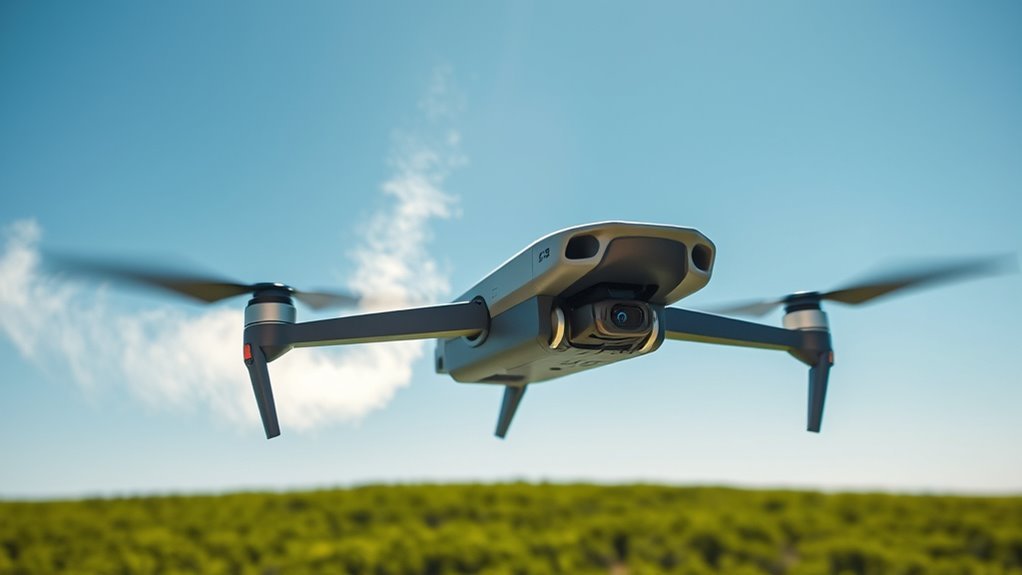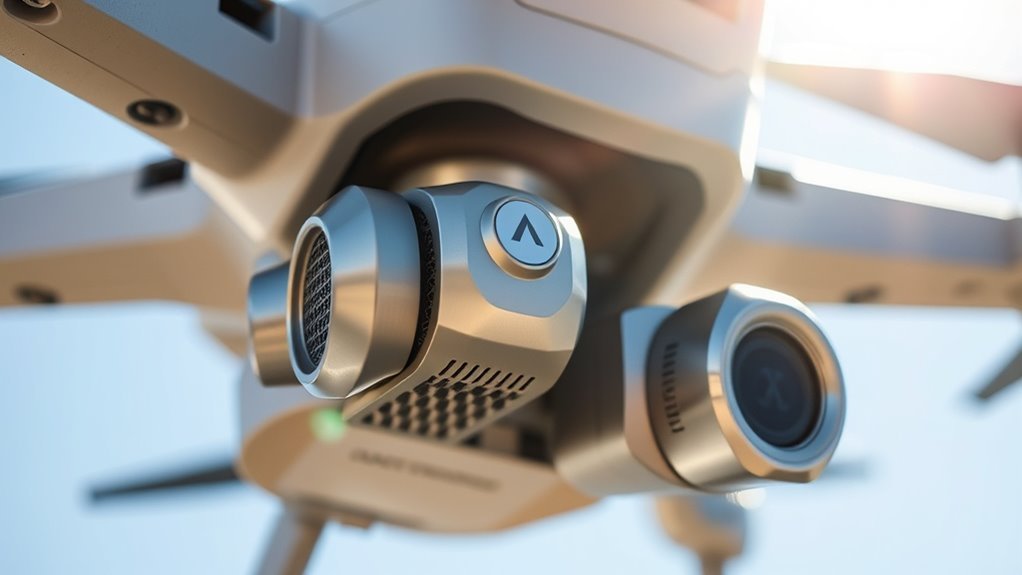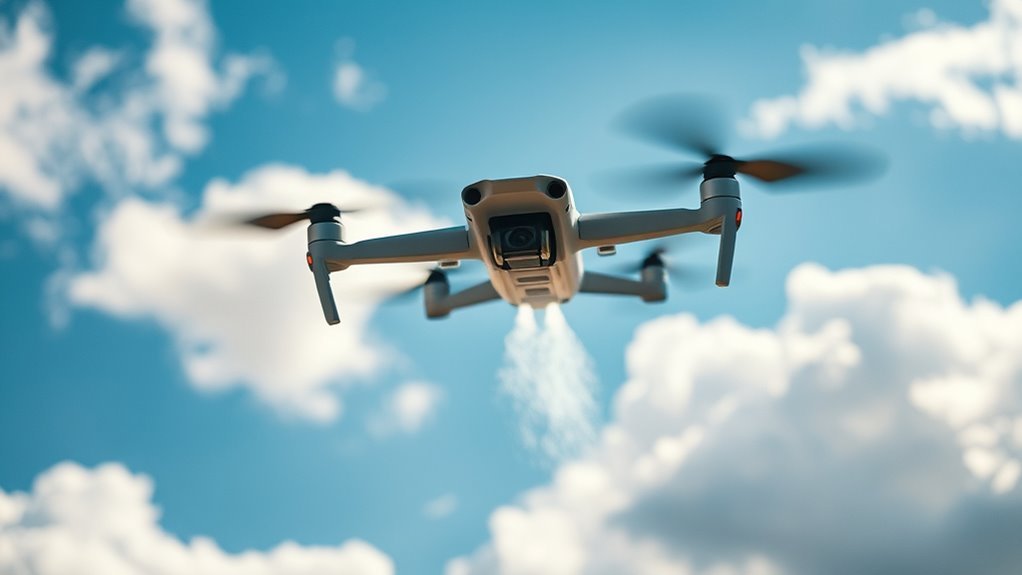To understand drone exhaust, you should recognize the types of drones—fixed-wing, multi-rotor, and hybrid—and their fuel sources, mainly batteries or gasoline. Each type emits different pollutants, including CO₂ and volatile organic compounds, which impact air quality and climate. Regulations exist to limit these emissions, promoting sustainability. Innovations like advanced battery tech and eco-friendly designs are shaping the future. There’s much more to uncover about drone emissions and their environmental implications.
Types of Drones and Their Fuel Sources

As drones become increasingly integral to various industries, understanding their types and fuel sources is essential. You’ll encounter several drone types, primarily categorized into fixed-wing, multi-rotor, and hybrid models. Fixed-wing drones offer longer flight times and range, relying typically on batteries or gasoline engines for power. Multi-rotor drones, popular for their maneuverability, generally utilize electric batteries as their primary fuel source. Hybrid drones combine the benefits of both, often using gasoline for extended range and batteries for short, agile flights. Each type serves distinct applications, from aerial photography to agricultural monitoring. Knowing these variations equips you with the insight to choose the right drone for your specific needs, enhancing your ability to operate freely and effectively in the field. Additionally, advanced camera capabilities in drones enhance the quality of visual content captured during flights, making them invaluable tools across various applications. Furthermore, battery performance, such as flight time, plays a crucial role in determining the overall efficiency and usability of drones in different scenarios.
Understanding Drone Emissions

The impact of drone emissions is gaining attention as the use of various drone types expands across industries. As you explore drone technology, it is crucial to understand the emissions associated with these devices and the importance of emission reduction strategies.
Understanding the emissions from drones is essential as their use grows across various industries.
- Drones can emit greenhouse gases depending on their fuel source.
- Electric drones typically produce lower emissions than their gas-powered counterparts.
- Regulatory frameworks are evolving to address emission standards for drone operations.
- Innovations in battery technology aim to minimize environmental impact.
- Additionally, energy consumption optimization through advanced algorithms is being implemented to further reduce carbon footprints during drone operations.
The Components of Drone Exhaust

When examining drone exhaust, you’ll encounter a complex mixture of chemical compounds that can greatly impact air quality. Understanding the chemical composition is essential for evaluating the potential effects of these emissions on the environment and public health. By analyzing these components, you can better grasp the broader implications of drone operation.
Chemical Composition Overview
Drone exhaust consists of several key components that contribute to its overall chemical profile. Understanding the chemical composition is essential for emission analysis and can help you grasp its environmental impact.
Here are some primary components you might encounter:
- Carbon Dioxide (CO₂): A major greenhouse gas resulting from combustion.
- Carbon Monoxide (CO): A toxic gas produced during incomplete combustion.
- Nitrogen Oxides (NOx): Contributes to air pollution and respiratory issues.
- Particulate Matter (PM): Tiny particles that can affect air quality and health.
Exhaust Emission Effects
Although drones are often praised for their efficiency and versatility, their exhaust emissions can pose significant environmental and health risks. The primary components of drone exhaust include carbon monoxide, nitrogen oxides, and particulate matter, which can adversely affect air quality. When you conduct an emission analysis, you’ll find that these pollutants can lead to respiratory issues and cardiovascular problems, impacting overall exhaust health. Additionally, the release of volatile organic compounds can contribute to smog formation, undermining the very freedoms drones aim to enhance. Understanding the implications of these emissions is vital for developing cleaner technologies and regulations, ensuring that the benefits of drone usage don’t come at an unacceptable cost to public health and the environment.
Environmental Impact of Drone Exhaust
When evaluating the environmental impact of drone exhaust, you need to contemplate both emissions and noise pollution. The emissions from drones can affect local air quality, introducing harmful pollutants into the atmosphere. Additionally, noise pollution from drone operations can disrupt ecosystems and affect human health, necessitating a thorough analysis of these factors.
Emissions and Air Quality
As the use of unmanned aerial vehicles (UAVs) increases, understanding their emissions becomes essential for evaluating their impact on air quality. UAVs emit pollutants that can affect urban environments, necessitating careful scrutiny and potential emission reduction strategies.
- VOCs (Volatile Organic Compounds) contribute to smog formation.
- Particulate matter can aggravate respiratory health issues.
- CO2 emissions contribute to climate change.
- Nitrogen oxides can lead to acid rain and ecosystem damage.
Monitoring these emissions is vital for maintaining air quality and ensuring that UAVs can operate without compromising environmental standards. As you consider the future of drone technology, balancing innovation with responsible practices will be key to protecting air quality and promoting sustainable development.
Noise Pollution Effects
While the emissions from drones primarily focus on air pollutants, their contribution to noise pollution also warrants attention due to its significant environmental impact. Drone soundscapes, characterized by high-pitched whirs and fluctuating tones, disrupt the acoustic environment, especially in urban areas. This urban noise can lead to increased stress levels, sleep disturbances, and reduced quality of life for residents. Furthermore, as drone usage escalates for deliveries and surveillance, cumulative noise exposure may impact wildlife behavior, disrupting natural habitats. It’s vital to recognize that while drones serve various functions, their auditory footprint can compromise tranquility in urban settings. Consequently, addressing noise pollution from drones is essential for maintaining both human and ecological health in our increasingly crowded environments.
Regulations and Standards for Drone Emissions
Although drone technology has advanced rapidly, regulations and standards for drone emissions remain essential for maintaining environmental sustainability. Understanding these frameworks allows you to navigate the complexities of regulatory compliance while promoting cleaner air. Here are some key aspects to contemplate:
- Emission standards set limits on pollutants released by drones.
- Regulatory compliance guarantees that manufacturers and operators meet these standards.
- Certification processes verify that drones adhere to established emission limits.
- Enforcement mechanisms help monitor compliance and impose penalties for violations.
Comparing Electric vs. Gas-Powered Drones
When evaluating drone performance, it is vital to take into account the differences between electric and gas-powered models. Electric drones offer several advantages, including lower operating costs, quieter operation, and reduced environmental impact. Their lightweight design enhances maneuverability and makes them ideal for hobbyists and commercial applications alike. On the other hand, gas-powered drones often have extended flight times and greater payload capacities, making them suitable for heavy-duty tasks. However, they come with significant drawbacks, such as higher emissions, increased noise levels, and more complex maintenance requirements. Ultimately, your choice between electric and gas-powered drones will depend on your specific needs, but understanding these key differences is essential for making an informed decision.
Innovations in Reducing Drone Emissions
As industries increasingly adopt drones for various applications, innovations aimed at reducing emissions have become critical to enhancing their sustainability. Advances in battery technology and hybrid systems are at the forefront, allowing for increased drone efficiency while minimizing environmental impact. Additionally, alternative fuels are being explored to replace traditional fuels, further lowering emissions. European brands’ focus on sustainable materials is also contributing to the reduction of the overall ecological footprint of drones.
- Eco-friendly designs that utilize lightweight materials
- Enhanced emission controls to limit pollutants
- Noise reduction technologies that create quieter operations
- Sustainable practices that incorporate renewable energy sources
These innovations not only improve drone performance but also align with global efforts to create cleaner, more sustainable aviation solutions. By embracing these technologies, you contribute to a future where drone usage is both efficient and environmentally responsible. Furthermore, eco-friendly design approaches support environmental stewardship while enhancing performance.
Best Practices for Eco-Friendly Drone Usage
To guarantee that your drone operations are environmentally responsible, it’s essential to adopt best practices that minimize their ecological footprint. Start by embracing sustainable flying techniques, such as optimizing flight paths for efficiency, which can considerably reduce energy consumption. Regular maintenance of your drone guarantees peak performance and lower emissions, promoting responsible usage. The Dji Mini 2, for instance, features up to 31 minutes of flight time under ideal conditions, which can help maximize your exploration while minimizing energy use. When planning flights, consider time-of-day factors to avoid wildlife disturbances and reduce noise pollution. Utilize eco-friendly batteries and recharge them using renewable energy sources whenever possible. Finally, stay informed about local regulations and guidelines to assure compliance, enhancing your drone’s sustainable impact. By integrating these practices into your operations, you’ll not only contribute to environmental preservation but also enjoy the freedom that responsible drone usage brings. Additionally, understanding signal attenuation is crucial for optimizing flight paths to minimize energy consumption and improve efficiency.
The Future of Drone Technology and Sustainability
While advancements in drone technology continue to reshape industries, their integration with sustainable practices is essential for reducing environmental impact. You’ll witness future innovations that prioritize eco-friendliness, enhancing both operational efficiency and environmental responsibility.
- Development of electric and hybrid drones to minimize emissions.
- Adoption of biodegradable materials in drone manufacturing.
- Implementation of AI for optimizing flight routes, reducing energy consumption, and real-time data processing will enhance decision-making during operations.
- Use of solar panels to extend flight times and decrease reliance on fossil fuels. Additionally, real-time data will play a crucial role in ensuring efficient operations and minimizing resource waste in future drone applications.
Frequently Asked Questions
How Does Drone Exhaust Differ From Traditional Vehicle Emissions?
Drone exhaust differs from traditional vehicle emissions in that drone technology often adheres to stricter emission standards, resulting in lower pollutants. Unlike gas-powered vehicles, drones typically use electric power, reducing harmful emissions considerably.
What Are the Health Risks Associated With Drone Emissions?
You might think drone emissions are harmless, but studies show potential health effects, including respiratory issues. While emission standards for drones are evolving, their impact on air quality warrants careful consideration and ongoing research for public safety.
Can Drone Exhaust Affect Local Air Quality?
Yes, drone exhaust can negatively impact local air quality. As drone technology advances, the potential for increased air pollution rises, which may lead to health risks and environmental concerns that affect your freedom and well-being.
How Often Should I Maintain My Drone to Reduce Emissions?
Think of your drone like a finely-tuned machine; a consistent maintenance schedule—every 25 flight hours—can greatly enhance performance and promote emission reduction. Regular checks guarantee it runs smoothly, keeping both air quality and your freedom intact.
Are There Specific Drones Designed for Minimal Exhaust Output?
Yes, there are specific drones designed for minimal exhaust output. Electric drones produce zero emissions, while hybrid drones combine electric and fuel power, greatly reducing exhaust. Choosing either can enhance your flying experience while minimizing environmental impact.

